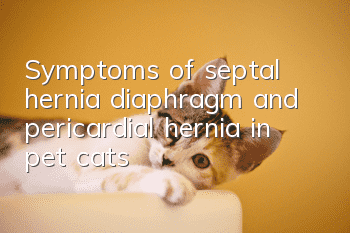Symptoms of septal hernia, diaphragm and pericardial hernia in pet cats

Many heart diseases in cats are caused by congenital factors. Of course, some are caused by later feeding. Heart disease is generally not discovered when cats are young. When cats are approaching old age, the symptoms of heart disease will appear. Slowly occur, different physical differences will produce a variety of different symptoms, septal hernia can also produce heart disease.
The so-called septal hernia refers to a congenital defect in the diaphragm that separates the chest and abdominal cavities, through which the stomach or intestines enter the chest. The most common is a defect on the right rear side. The stomach or intestines entering the chest compress the lungs This can cause difficulty breathing.
Diaphragmatic hernia of the peritoneal pericardial sac is the most common congenital pericardial malformation in cats. It is abnormal embryonic development that results in the persistence of pericardial-abdominal communication in the midline of the abdomen and is associated with a number of congenital developmental anomalies, such as sternal malformations (especially in cats), anterior abdominal hernias, and ventricular septal defects. Persian cats have a breed susceptibility, with males being more susceptible than females.
The clinical symptoms of peritoneal pericardial sac and diaphragmatic hernia depend on the nature and volume of the herniated abdominal contents. Some sick animals do not have any clinical symptoms, and PPDH is diagnosed by physical examination. Animals with symptoms usually have digestive tract or respiratory symptoms: vomiting, diarrhea, anorexia, weight loss, abdominal pain, coughing, difficulty breathing, mostly due to a large number of abdominal viscera compressing the heart or lungs and abdominal viscera (such as liver and small intestine). caused by closure.
The diagnosis by There are abnormal fat and/or gas density images in the memory. Abdominal X-ray images are empty. For cases that are difficult to diagnose with ordinary X-ray examination, X-ray angiography can be used to evaluate the diaphragm. The diaphragm can be comprehensively evaluated by injecting a water-soluble positive contrast agent into the abdominal cavity at a dose of 1 to 2 ml/kg, and then taking right, left, dorsal and ventral X-rays. The presence of contrast material in the chest confirms the diagnosis of diaphragmatic rupture. A barium meal image shows the bowel across the diaphragm and into the pericardial sac. Echocardiography is helpful in confirming the diagnosis of suspected animals and can detect abnormal organ images in the pericardium.
Surgical treatment is the best option in this case. The hernia contents are repositioned and the hernia ring is closed surgically. The success rate of the operation is usually relatively high. Conservative treatment is also an option for animals without clinical symptoms.
- Can cats eat peanuts?
- What do California Shiny Cats eat? Feeding Guide for California Shiny Cats
- How to raise a Siamese cat Raising a Siamese cat needs to be serious and careful!
- Can Fold-eared cats eat Wangzai?
- Where can I adopt a cat? Is it free?
- Cat pad shape and personality
- What should I pay attention to a few hours after neutering a male cat?
- Why do cats like to sleep?
- Can cataracts be cured in cats?
- How to raise a golden cat? How to care for the golden layer?



